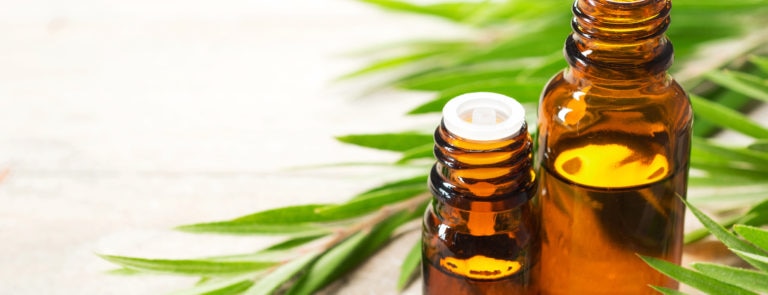15% off €35 OR 20% off €45
Tea tree oil: Uses and benefits

Tea tree oil - what is it and what can it be used for? Keep reading to find out!
What is tea tree oil?
Pure tea tree oil is made by extracting the oil from the leaves of the tea tree.
Not to be confused with the common tea plant we use to make black and green tea, the tea tree in question was first discovered by sailors.
When they arrived on the swampy south-east Australian (its native country) coast in the 18th century, these thirsty seadogs used the leaves of the tea tree to make a tea with a nutmeg aroma.
Nowadays, tea tree essential oil is used for all sorts of things, including, skin problems and dandruff. However, like many herbal remedies, most of these claimed benefits are not backed by strong scientific evidence yet.
What are tea tree oil benefits?
Tea tree oil has quite a potent herbal smell, which is not for everyone, so it’s not likely to be one for putting in your oil burner!
Tea tree oil has been used throughout history for many reasons as it’s believed to have antibacterial properties.
Read a little about the most popular tea tree oil uses below:
Tea tree oil for hair
You may have already come across tea tree oil on the back of shampoo and conditioner products, but do you know why?
Essential oils are often mixed into hair products either for their naturally pleasant smells, the positive changes they can make to your hair, or both!
Tea tree oil is said to support natural hair growth and help people who suffer with dandruff. Here’s how:
-
Dandruff
This annoying and sometimes embarrassing condition is caused by a build-up of dry, scaly skin on your scalp, which if left unaddressed, can prevent your hair from growing to its full potential – and the white flakes aren’t too fun either!
Tea tree oil shampoo will have cleansing properties, which may help fight whatever is causing the accumulation of dead skin on your scalp.
Handpicked content: How to get rid of dandruff
-
Healthy hair growth
Sometimes hair growth gets hindered by a build-up of hair products and the overuse of hair products in general, which can increase the risk of hair breakage and excessive shedding.
Opting for natural (diluted) tea tree oil can help prevent the build-up of dead skin and deposits on the hair shafts, which can ‘free’ the hair and help it grow at its normal rate.
Commonly recommended dosage
If you want to tackle dandruff, choose a shampoo with 5% tea tree oil.
If you want to make your own essential oil treatment to help maintain healthy hair, dilute tea tree oil 1:10 with a carrier oil like almond oil, or just mix a few drops into your shampoo or conditioner.1
Please note:
If you are genetically pre-disposed to losing hair, have hair loss associated with ageing or are going through treatment like chemotherapy which often results in hair loss, tea tree oil is not likely to help with your hair loss. It may help keep your scalp nice and clean though!
We recommend you seek advice from a healthcare professional if you suffer from any underlying conditions which affect hair growth.
Tea tree oil for spots
Spots normally pop up when our skin produces excess sebum (natural skin oil) which can cling onto dead skin and cause spots.
However, they can also crop up because of bacteria growth on the skin, and as tea tree oil has natural antibacterial properties, it could help to prevent control this type of spot.2
Experiments have also found that using tea tree oil to combat spots has fewer side effects for some people in comparison to using conventional spot treatments like benzoyl peroxide.3
Always dilute tea tree oil with a suitable carrier oil before applying directly to the skin.
Commonly recommended dosage
Most skin formulas contain 5% tea tree oil.
Tea tree side effects
When tea tree oil is applied to this skin, it is usually safe for most people if diluted properly with a carrier oil or water.
However, it can cause skin swelling, irritation, dryness, itchiness, redness and burning. This is why you should always do a patch test.
8 tea tree oil uses (some might surprise you)
The cleansing powers of tea tree oil are down to its natural antibacterial and antifungal properties.
In simple terms, the natural chemicals in this oil can help manage bacteria and fungus.
And this is why it’s so popular in skincare and for managing numerous skin concerns.
But its purifying prowess doesn’t just work on your complexion.
How to use tea tree oil
Here are some of the ways you can use tea tree oil:
- Natural hand gel
- On minor scrapes
- Care for sensitive skin and blemish breakouts
- Counteract nail fungus
- Manage body odour
- Keep insects away
- Clean surfaces
- Manage athlete’s foot
Tea tree oil uses
Here we outline some of the most popular tea tree oil uses that show it’s far more than a skin-soothing superhero. And this is just the tip of the iceberg.
Tea tree oil may be helpful for other reasons too. For example, it could help with gingivitis, dandruff and to repel lice. But as yet, there isn't sufficient evidence to back up these claims.
Natural hand gel
Due to its bacteria-combatting capabilities, tea tree oil makes a great natural cleansing ingredient for hand sanitisers.
Sensitive skin and blemish breakouts
From spots and insect bites to skin conditions, when applied to sensitive skin, tea tree oil can help to calm redness and itchiness.
Although it may take longer to act than other more aggressive treatments – for example, benzoyl peroxide on spots – it can be a gentler option for delicate facial skin.4
Handpicked content: What is sensitive skin?
Preventing body odour
Tea tree oil’s natural anti-bacterial properties make it a great odour-fighting ingredient for natural deodorants.
Handpicked content: 6 of the best natural deodorants
Keep insects away
This natural oil has been known to be as effective at repelling insects as many standard insecticides and repellents.
It makes an effective DIY bug spray if you want to avoid DEET.5
Clean surfaces
Mix tea tree oil with water and vinegar to make an all-purpose cleaner for your home that’s free from chemicals.
Handpicked content: 10 of the best eco-cleaning products
Is tea tree oil safe?
For most people, tea tree oil is safe as a topical treatment.
But it contains a few more volatile compounds that some individuals may find sensitizing.
Allergic reactions can happen, especially when tea tree oil is used in 100% strength.
This is why you’ll usually find lower concentrations of this plant oil in skincare.
If your skin is prone to irritation and sensitivity, you could try diluting it using olive oil, coconut oil or almond oil before applying.
As a precaution, it’s best to test tea tree oil on a small patch of skin first to check for any reaction.
However, it’s important to add, tea tree oil is toxic, so it must not be swallowed. As a result, it’s probably best to avoid applying it to the skin around your mouth.
- https://www.ncbi.nlm.nih.gov/pmc/articles/PMC6236410/
- http://europepmc.org/article/med/2145499
- https://www.webmd.com/vitamins/ai/ingredientmono-113/tea-tree-oil
- https://pubmed.ncbi.nlm.nih.gov/26412058/



